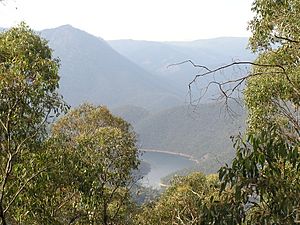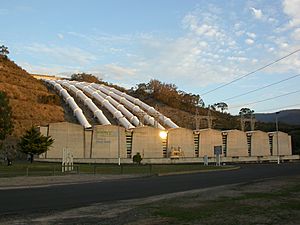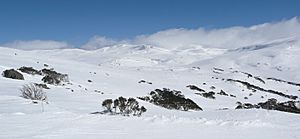Snowy Mountains Scheme facts for kids
Quick facts for kids Snowy Mountains Scheme |
|
|---|---|

Map of Snowy Mountains Scheme
|
|
| Country | Australia |
| Location | Kosciuszko National Park, New South Wales |
| Coordinates | 36°07′S 148°36′E / 36.12°S 148.6°E |
| Purpose | Hydroelectricity and irrigation project |
| Status | Operational |
| Construction began | 17 October 1949 |
| Opening date | 21 October 1972 |
| Construction cost | A$820 million |
| Operator(s) | Snowy Hydro Limited |
The Snowy Mountains Scheme is a huge project in south-east Australia. It helps create electricity and provides water for farms. This amazing project is located near the border of New South Wales (NSW) and Victoria (Australia).
The Scheme includes sixteen big dams, nine power stations, and two pumping stations. It also has 225 kilometres of tunnels, pipelines, and aqueducts. These were all built between 1949 and 1974. Sir William Hudson was the main engineer who oversaw this massive construction. It is the largest engineering project ever done in Australia.
The project captures water from the Snowy River and its smaller rivers. This water used to flow towards the Tasman Sea. Now, it is sent inland to the Murray and Murrumbidgee Rivers. This helps irrigate farms in those areas.
The Scheme has two main tunnel systems. They go through the Snowy Mountains, also known as the Great Dividing Range. The water drops 800 metres through these tunnels. This fall helps power large hydro-electric stations. These stations create electricity for the Australian Capital Territory, New South Wales, and Victoria.
The Scheme also makes sure there's enough water in the Murray-Darling Basin. It provides about 2,100 billion litres of water each year. This water is vital for Australia's farming industry, especially for irrigation.
In 2016, the Snowy Mountains Scheme was added to the Australian National Heritage List. This means it's a very important part of Australia's history and culture.
Contents
History of the Snowy Scheme
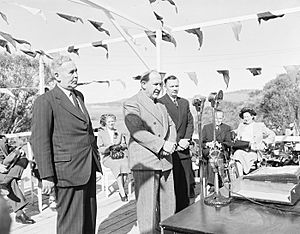
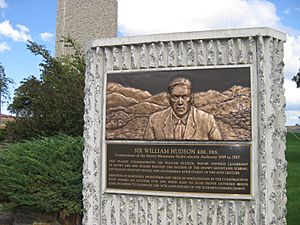
Why the Scheme Was Built
For a long time, the Murray and Murrumbidgee rivers were used for water supply and irrigation. But the Snowy River, which starts in the Australian Alps, flowed mostly unused into the Tasman Sea. It has the highest starting point of any river in Australia.
After World War II, people saw a chance to use the Snowy River's water. The government of New South Wales wanted to send the water to the Murrumbidgee River for farming. Victoria wanted to use it for electricity and send it to the Murray River. South Australia was worried about less water flowing down the Murray.
To solve this, the Australian government brought everyone together. In 1948, a committee suggested a much bigger plan. It involved diverting not just the Snowy River, but also other rivers in the area. This plan was agreed upon by the governments of Australia, New South Wales, and Victoria.
Because of Australia's laws, the national government needed the states' agreement. So, the government passed a law to create the Snowy Mountains Hydroelectric Authority. This group was in charge of planning and building the Scheme. The final plan was to use the Snowy Mountains' water for more electricity and to provide water for dry farming areas in the west. Australians were very excited about this project.
New Zealand-born William Hudson was chosen to lead the Scheme. He was knighted in 1955 for his work. Sir William was told to find workers from other countries. He hired people from 32 different nations, many of whom had been enemies just a few years before. This mix of cultures had a big impact on Australia.
Building the Scheme

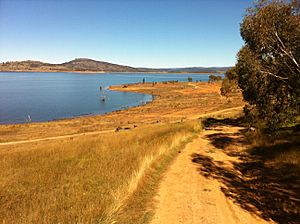
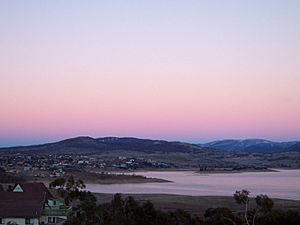

Construction of the Snowy Scheme started on October 17, 1949. It took 25 years to build and was finished in 1974.
The United States helped by providing technical advice and training engineers. In 1962, Australia got a loan of $100 million from the World Bank.
Workers set new records for digging tunnels. The project was finished on time and within budget, costing 820 million Australian dollars. This would be about A$6 billion today. About two-thirds of the workers were immigrants from over thirty countries. Sadly, 121 workers died during the construction.
The project built 1,600 kilometres of roads and tracks. Seven towns and over 100 camps were also built. These were needed to construct the 16 major dams, seven power stations, two pumping stations, 145 kilometres of tunnels, and 80 kilometres of pipelines. Only 2% of the construction work is visible above ground.
Two towns built for the Scheme are still there today: Cabramurra, which is Australia's highest town, and Khancoban. Cooma grew a lot during construction and is still the main office for the company that runs the Scheme. The towns of Adaminaby, Jindabyne, and Talbingo were flooded to create large lakes like Lake Eucumbene and Lake Jindabyne.
The Scheme is located in an area of 5,124 square kilometres, mostly within the Kosciuszko National Park. Over 100,000 people worked on the project. Many were new immigrants to Australia after World War II. The Scheme was very important for Australia's growth after the war. Seventy percent of all workers were immigrants.
The project even used Australia's first transistor computer, called 'Snowcom', from 1960 to 1967.
After the project was done, the Australian government kept many of the skilled workers. They formed the Snowy Mountains Engineering Corporation (SMEC), which is now a global engineering company. The Scheme is the largest source of renewable energy in mainland Australia. It provides about 67% of all renewable energy in the National Electricity Market.
The Scheme also helps manage water for the Murray-Darling Basin. It provides about 2,100 billion litres of water each year. This extra water helps the farming industry, which is worth about A$3 billion annually.
The Snowy Mountains Hydro-electric Scheme is one of the most complex water and power projects in the world. The American Society of Civil Engineers calls it a "world-class civil engineering project." It connects seven power stations and 16 major dams using 145 kilometres of tunnels and 80 kilometres of aqueducts. The Scheme played a big part in building Australia after World War II.
Sir William Hudson was the first leader of the Snowy Mountains Hydroelectric Authority from 1949 to 1967. He managed the whole Scheme, met with government officials, and encouraged scientific research. Sir William believed in teamwork between managers and workers.
The Scheme was officially completed when the Tumut 3 Power Station project was opened by the Governor-General of Australia, Sir Paul Hasluck, on October 21, 1972.
Safety Measures
The Scheme used new ideas for safety during its construction. For example, all vehicles on the project had to have seatbelts for the driver and front passenger. And everyone had to wear them.
On April 16, 1958, an elevator at a dam near Cabramurra fell about 400 feet. The cable broke, and four Italian workers died.
Stories from the Snowy Scheme
Many stories and memories have been shared about working on the Snowy Mountains Scheme. Siobhan McHugh's book, The Snowy: The People Behind the Power, tells many of these stories. It won an award and was used for a radio show and a documentary. Her book is based on about 90 interviews with former workers and residents.
Recently, Snowy Hydro and other groups worked together on a project. They helped former workers and their families create short films about their experiences. These films show what life was like building the Scheme between 1949 and 1974. The project's artistic director, Jenni Savigny, said it was important to tell the history in the workers' own words. She said, "You just get a personal sense of what it was like to be there, and what it meant to people's lives."
These films were shown for the first time on June 7, 2018, in Canberra. You can watch them on the Woden Community Service YouTube Channel.
How the Scheme Works Today
The Scheme is run by Snowy Hydro Limited. This company is owned by the Australian Federal government.
There are plans to expand the Snowy Scheme even more. This project, called Snowy 2.0, was announced in 2017. It aims to add 2 gigawatts of pumped storage capacity. This means it can store energy for about a week. It will involve building new tunnels and power stations, but no new dams. This expansion is expected to be finished by 2026.
Environmental Concerns
The original plan for the Scheme was to divert almost all (99%) of the Snowy River's natural water flow. Water was released only for people using the riverbanks, not for the river's natural environment. Soon, it became clear that this caused big problems for the lower parts of the Snowy River.
Many people campaigned to help the river. In 1998, an inquiry was set up. It suggested increasing the water flow to 15% of its natural level. The governments of New South Wales and Victoria were unsure about this goal. Some thought the Murray River's health was more important than the Snowy's.
In 2000, Victoria and NSW agreed to a long-term goal of 28% water flow. This required A$156 million to make up for losses to farmers. In 2002, flows were increased to 6%. The goal was to reach 21% within 10 years. By 2017, the 21% target was finally reached for the first time.
Some water managers, conservationists, and farmers still want more water returned to the Snowy River. The Snowy River Alliance, formed in 1996, holds an annual "Snowy River Day." This day marks when water was first released into the Snowy River in 2002.
Special flows of water are important for the river's environment. These "flushing flows" help important animals like the Australian platypus and native Australian Bass.
Main Parts of the Scheme
Construction of the Scheme began in 1949 and was completed in 1974. The Guthega power station started producing electricity on February 21, 1955.
Power Stations
| Hydro-electric power station | Installed capacity (MW) |
HP (Thou) |
Year completed |
|---|---|---|---|
| Guthega | 60 | 80 | 1955 |
| Tumut 1 | 330 | 440 | 1958 |
| Tumut 2 | 286.4 | 384 | 1961 |
| Blowering | 80 | 110 | 1967 |
| Murray 1 | 950 | 1,270 | 1967 |
| Murray 2 | 550 | 740 | 1969 |
| Tumut 3 | 1,800 | 2,210 | 1973 |
| Tumut 3 Micro Hydro | 0.72 | 0.97 | 2004 |
| Jounama Small Hydro | 14.4 | 19.3 | 2010 |
| Jindabyne Dam Mini Hydro | 1.1 | 1.5 | 2011 |
The power stations in the Scheme can produce a total of 4.073 gigawatts of electricity.
Major Dams and Reservoirs
The largest dam in the Scheme is Talbingo Dam. It has a huge wall that is 161.5 metres high. Khancoban Dam is the longest dam, with a top length of 1,067 metres. Many different types of dams and spillways were built.
Lake Eucumbene is the biggest reservoir in the Scheme. It can hold 4,798.4 billion litres of water. The smallest is Deep Creek Reservoir, holding only 11 million litres.
| Dam constructed | Year completed |
Impounded body of water |
Reservoir capacity | Dam wall height | Crest length | Dam type | Spillway type | ||
|---|---|---|---|---|---|---|---|---|---|
| ML | mill. imp gal | mill. US gal | |||||||
| Blowering Dam | 1968 | Blowering Reservoir | 1,628,000 | 358,000 | 430,000 | 112 m (367 ft) | 747 m (2,451 ft) | Rockfill embankment | Concrete chute |
| Deep Creek Dam | 1961 | Deep Creek Reservoir | 11 | 2.4 | 2.9 | 21 m (69 ft) | 55 m (180 ft) | Concrete gravity | Uncontrolled |
| Eucumbene Dam | 1958 | Lake Eucumbene | 4,798,400 | 1,055,000 | 1,267,600 | 116 m (381 ft) | 579 m (1,900 ft) | Earthfill embankment | Overflow ski-jump and bucket |
| Geehi Dam | 1966 | Geehi Reservoir | 21,093 | 4,640 | 5,572 | 91 m (299 ft) | 265 m (869 ft) | Rockfill embankment | Bell Mouth |
| Guthega Dam | 1955 | Guthega Reservoir | 1,604 | 353 | 424 | 34 m (112 ft) | 139 m (456 ft) | Concrete gravity | Uncontrolled |
| Happy Jacks Dam | 1959 | Happy Jacks Pondage | 271 | 60 | 72 | 29 m (95 ft) | 76 m (249 ft) | Concrete gravity | Uncontrolled |
| Island Bend Dam | 1965 | Island Bend Pondage | 3,084 | 678 | 815 | 49 m (161 ft) | 146 m (479 ft) | Concrete gravity | Controlled |
| Jindabyne Dam | 1967 | Lake Jindabyne | 688,287 | 151,402
j |
181,826 | 72 m (236 ft) | 335 m (1,099 ft) | Rockfill embankment | Controlled |
| Jounama Dam | 1968 | Jounama Pondage | 43,542 | 9,578 | 11,503 | 44 m (144 ft) | 518 m (1,699 ft) | Rockfill embankment | Controlled |
| Khancoban Dam | 1966 | Khancoban Reservoir | 26,643 | 5,861 | 7,038 | 18 m (59 ft) | 1,067 m (3,501 ft) | Earthfill embankment | Controlled |
| Murray Two Dam | 1968 | Murray Two Pondage | 2,344 | 516 | 619 | 43 m (141 ft) | 131 m (430 ft) | Concrete arch | Controlled |
| Talbingo Dam | 1970 | Talbingo Reservoir | 921,400 | 202,700 | 243,400 | 162 m (531 ft) | 701 m (2,300 ft) | Rockfill embankment | Concrete chute |
| Tantangara Dam | 1960 | Tantangara Reservoir | 254,099 | 55,894 | 67,126 | 45 m (148 ft) | 216 m (709 ft) | Concrete gravity | Concrete chute |
| Tooma Dam | 1961 | Tooma Reservoir | 28,124 | 6,186 | 7,430 | 67 m (220 ft) | 305 m (1,001 ft) | Concrete embankment | Concrete Chute |
| Tumut Pond Dam | 1959 | Tumut Pond Reservoir | 52,793 | 11,613 | 13,946 | 86 m (282 ft) | 218 m (715 ft) | Concrete arch | Controlled |
| Tumut Two Dam | 1961 | Tumut Two Pondage | 2,677 | 589 | 707 | 46 m (151 ft) | 119 m (390 ft) | Concrete gravity | Controlled |
Tunnels
| Tunnel | Length
(km) |
Percentage
Lined |
Capacity
(m3/s) |
Section | Year
Completed |
|---|---|---|---|---|---|
| Murrumbidgee-Eucumbene | 16.6 | 17.7% | 17 | Horseshoe | 1961 |
| Eucumbene-Tumut | 22.2 | 28.3% | 113.2 | Circular | 1959 |
| Tooma-Tumut | 14.3 | 20% | 38.5 | Combination | 1961 |
| Tumut 1 Pressure | 2.4 | 100% | 124.6 | Circular | 1959 |
| Tumut 1 Tailwater | 1.3 | 54.5% | 124.6 | Horseshoe | 1959 |
| Tumut 2 Pressure | 4.8 | 100% | 124.6 | Circular | 1961 |
| Tumut 2 Tailwater | 6.4 | 100% | 124.6 | Circular | 1961 |
| Guthega Pressure | 4.6 | 11.6% | 34 | Horseshoe | 1955 |
| Eucumbene-Snowy | 23.5 | 19.7% | 96.3 | Horseshoe | 1965 |
| Jindabyne-Island Bend | 9.8 | 10.6% | 25.5 | Combination | 1968 |
| Snowy-Geehi | 14.5 | 13.3% | 113.2-147.2 | Horseshoe | 1966 |
| Murray 1 Pressure | 12 | 189.2 | |||
| Murray 2 Pressure | 2.4 | 100% | 243.5 | Horseshoe | 1969 |
Pumping Stations
The Snowy Mountains Scheme has two pumping stations. The one at Tumut 3 Power Station can pump water back up to Talbingo Reservoir. The Jindabyne Pumping Station pumps water from Lake Jindabyne through a tunnel to Island Bend.
Future Expansion Plans
In 2017, the Australian government suggested a $2 billion project to expand the Snowy Mountains Scheme. This project, called Snowy 2.0, will add more power storage. It will build new tunnels and power stations, but no new dams. This expansion started in 2019 and should be finished by 2026.
Tourism in the Snowy Mountains
The Snowy Scheme is a popular place for tourists. People enjoy driving tours to see the dams and lakes. These tours often start from towns like Cooma, Adaminaby, and Jindabyne. They use roads built for the Scheme, like the Snowy Mountains Highway and Alpine Way. Visitors can see Cabramurra, Australia's highest town, and impressive dam walls. Fishing for trout is also popular in the Scheme's lakes, especially Lake Jindabyne and Lake Eucumbene.
The Snowy Scheme Museum opened in Adaminaby in 2011. It tells the story of the Scheme's history.
Skiing in Australia began in the Snowy Mountains in the 1860s. But the building of the Snowy Scheme from 1949 really helped the ski industry grow. Many experienced European skiers came to work on the Scheme. This led to the creation of major ski resorts like Thredbo and Perisher. The building of Guthega Dam brought skiers to the Guthega area.
Engineering Award
The Scheme is recognized as a National Engineering Landmark by Engineers Australia. This is part of their program to honour important engineering projects.
See also
 In Spanish: Plan Snowy Mountains para niños
In Spanish: Plan Snowy Mountains para niños
- Snowy A TV series from the 1990s set in the Scheme.
- Bradfield Scheme, a similar idea for Queensland.
- Economic history of Australia
- National Electricity Market
- Kiewa Hydroelectric Scheme



